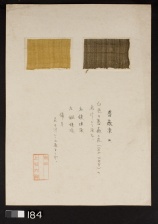Difference between revisions of "Hakushoku no bara - left (184 L)"
Jump to navigation
Jump to search
(username removed) |
(username removed) |
||
| Line 5: | Line 5: | ||
| 184 | | 184 | ||
|- | |- | ||
| − | ! scope="row"| | + | ! scope="row"|Uemura number / title |
| − | | | + | | ; "Haze-some 25" |
|- | |- | ||
! scope="row"|Folder location | ! scope="row"|Folder location | ||
| Line 44: | Line 44: | ||
| - | | - | ||
|- | |- | ||
| − | ! scope="row"| | + | ! scope="row"|Uemura's notes |
| It was not possible to color a fabric by rubbing fresh petals of this rose. | | It was not possible to color a fabric by rubbing fresh petals of this rose. | ||
|- | |- | ||
| − | ! scope="row"| | + | ! scope="row"|Uemura's date |
| Kyoto | | Kyoto | ||
|} | |} | ||
| − | [[Category: | + | [[Category:Uemura dye archive]] |
Latest revision as of 07:18, 24 July 2013
| Museum number | 184 |
|---|---|
| Uemura number / title | ; "Haze-some 25" |
| Folder location | 3rd shelf |
| Sample location | left (184 L) |
| Fiber type | silk |
| Color | mustard yellow |
| Dyestuff (Japanese common name) | 白色の薔薇 : Hakushoku no bara |
| Dye (English common name) | Tea rose*/white rose |
| Dyestuff (botanical name) | Rosa X centifolia L. (?) |
| Plant part | flower /fresh (?) |
| Dyestuff extraction | boiled in water |
| Auxiliary agent in dye bath | - |
| Mordant | copper |
| Other auxiliary agent | - |
| Uemura's notes | It was not possible to color a fabric by rubbing fresh petals of this rose. |
| Uemura's date | Kyoto |
